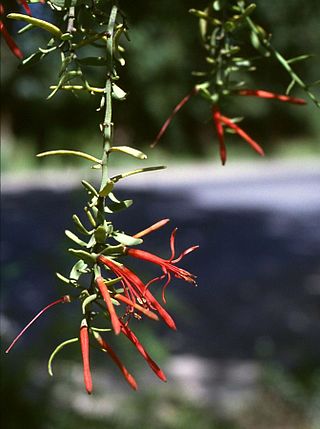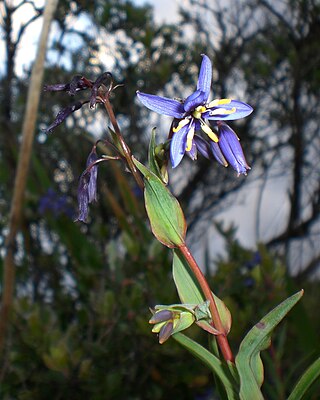
Cuscuta, commonly known as dodder or amarbel, is a genus of over 201 species of yellow, orange, or red parasitic plants. Formerly treated as the only genus in the family Cuscutaceae, it now is accepted as belonging in the morning glory family, Convolvulaceae, on the basis of the work of the Angiosperm Phylogeny Group. The genus is found throughout the temperate and tropical regions of the world, with the greatest species diversity in subtropical and tropical regions; the genus becomes rare in cool temperate climates, with only four species native to northern Europe.

Loranthaceae, commonly known as the showy mistletoes, is a family of flowering plants. It consists of about 75 genera and 1,000 species of woody plants, many of them hemiparasites. The three terrestrial species are Nuytsia floribunda, Atkinsonia ligustrina, and Gaiadendron punctatum Loranthaceae are primarily xylem parasites, but their haustoria may sometimes tap the phloem, while Tristerix aphyllus is almost holoparasitic. For a more complete description of the Australian Loranthaceae, see Flora of Australia online., for the Malesian Loranthaceae see Flora of Malesia.

Cassytha is a genus of some two dozen species of obligately parasitic vines in the family Lauraceae. Superficially, and in some aspects of their ecology, they closely resemble plants in the unrelated genus Cuscuta, the dodders. When fruit and flowers are absent in the field, the physical resemblance is so close that few people without technical training can discern the difference. In this respect and in their ecology the two genera present a spectacular example of convergent evolution. Nonetheless, Nickrent comments that "Cassytha is uneqivocally assigned to Lauraceae based on (both) morphological and molecular data." In its divergence from habits typical of the Lauraceae, Cassytha also presents examples of mosaic evolution

A parasitic plant is a plant that derives some or all of its nutritional requirements from another living plant. They make up about 1% of angiosperms and are found in almost every biome. All parasitic plants develop a specialized organ called the haustorium, which penetrates the host plant, connecting them to the host vasculature – either the xylem, phloem, or both. For example, plants like Striga or Rhinanthus connect only to the xylem, via xylem bridges (xylem-feeding). Alternately, plants like Cuscuta and some members of Orobanche connect to both the xylem and phloem of the host. This provides them with the ability to extract resources from the host. These resources can include water, nitrogen, carbon and/or sugars Parasitic plants are classified depending on the location where the parasitic plant latches onto the host, the amount of nutrients it requires, and their photosynthetic capability. Some parasitic plants can locate their host plants by detecting volatile chemicals in the air or soil given off by host shoots or roots, respectively. About 4,500 species of parasitic plants in approximately 20 families of flowering plants are known.

Calectasia is a genus of about fifteen species of flowering plants in the family Dasypogonaceae and is endemic to south-western Australia. Plants is this genus are small, erect shrubs with branched stems covered by leaf sheaths. The flowers are star-shaped, lilac-blue to purple and arranged singly on the ends of short branchlets.

Cuscuta californica is a species of dodder known by the common names chaparral dodder and California dodder. This is an annual parasitic plant that may resemble fine strands of spaghetti or twine strewn across other species in its habitat. A mature plant of this species may fulfill all of its food and water needs from the host plant, but they rarely kill their host. It is native to western United States and Baja California in Mexico.

Cuscuta europaea, the greater dodder or European dodder, is a parasitic plant native to Europe, which belongs to the family Convolvulaceae, but was formerly classified in the family Cuscutaceae. It grows on Asteraceae, Cannabaceae, Chenopodiaceae, Fabaceae, Urticaceae and other herbaceous plants, including garden plants such as Coleus and Impatiens, and more occasionally on Humulus. It is a notable parasite of lucerne. In many regions, including the Nepal Eastern Himalayas, this species are used as traditional medicine to treat hepatic diseases.

Cuscuta salina is a species of dodder known by the English name salt marsh dodder and is a native plant of western North America. The habitat includes coastal tidal wetlands in California, as well as saline habitats away from the coast, such as vernal pools and salt flats. Salt Marsh Dodder is a parasitic plant, wrapping orange-colored stems around natural wetland vegetation and absorbing nutrients of host plants via their specialized structures called haustoria.

Stypandra glauca, commonly known as the nodding blue lily, is a flowering plant in the family Asphodelaceae. It is a rhizomatous perennial plant with blue lily-like flowers with yellow stamens. It is widespread across southern areas of Australia.

Cassytha melantha is a parasitic vine. Common names include coarse dodder-laurel and large dodder-laurel. The fruits are about 10–15 millimetres (0.39–0.59 in) in diameter and are green, drying to black. These are edible and are harvested in the wild.

Pseuderanthemum variabile, commonly known as pastel flower or love flower in its native range, or night and afternoon in the USA, is a small perennial herb in the family Acanthaceae which is native to Australia, Papua New Guinea and New Caledonia. It can be an unwelcome nuisance in orchid nurseries in Australia.

Marsdenia suaveolens, commonly known as the scented milk vine, is a small vine found in New South Wales, Australia. It is found in a variety of habitats in relatively high rainfall areas, from Bega to Port Macquarie. The original specimen was collected at Sydney on 11 May 1802.

Cassytha glabella, commonly known as the slender devil's twine, is a common twining plant of the Laurel family, found in many of the moister parts of Australia. A hemi-parasitic climber. The specific epithet glabella is from Latin, referring to the lack of hairs. The fruit are sweet and mucousy to taste. The Devil's Twine and Cassytha melantha are similar, but with thicker hairier stems.

Cuscuta pacifica is a species of dodder. Its common name is goldenthread.

Cassytha filiformis or love-vine is an orangish, wiry, parasitic vine in the family Lauraceae. It is found in coastal forests of warm tropical regions worldwide including the Americas, Indomalaya, Australasia, Polynesia and tropical Africa.

Veronica calycina, commonly known as hairy speedwell or cup speedwell, is a flowering plant in the family Plantaginaceae. It is a trailing perennial with dark green leaves, purple-blue flowers and is endemic to Australia.

Cuscuta gronovii is a yellow vine that grows as a parasite off other plants. It is a dicot.

Amyema melaleucae, also known as the tea-tree mistletoe, is a species of flowering plant within the genus Amyema, an epiphytic hemiparasitic plant of the family Loranthaceae native to Australia and found in Western Australia and South Australia on the coast, from north of Perth almost to the Victorian border.

Cassytha racemosa is a parasitic perennial in the Lauraceae family. It is found in Western Australia.

Gambelia juncea is a species of flowering shrub in the plantain family commonly known as the Baja California bush snapdragon or Baja bush snapdragon. Gambelia juncea is a highly variable woody perennial to 1 m (3.3 ft) characterized by long, arching, reed-like stems and showy, bright red, two-lipped tubular flowers. Native to the Baja California peninsula and coastal Sonora, this species is widespread in the region across numerous habitats and has several varieties. It was formerly placed in the primarily South American genus Galvezia, but taxonomic studies have supported the reclassification of the two North American species into Gambelia. This species, with a number of cultivars, is widely used as an ornamental shrub for xeriscaping, erosion control, native plant gardens, and wildlife gardens.






















